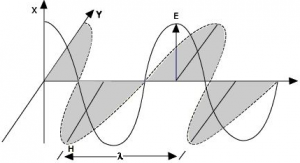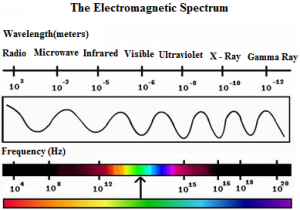Electromagnetic Waves
Electromagnetic waves are formed when an electric field comes in contact with a magnetic field. They are hence known as “Electromagnetic Waves”. The electric field and magnetic field of an electromagnetic wave are perpendicular (at right angles) to each other. They are also perpendicular to the direction of the EM wave.
The waves are defined as the disturbance through any medium of substance. The electromagnetic waves are the waves which are generated by coupling of magnetic field with electric field. These waves are in perpendicular direction to both the electric and magnetic and also perpendicular to each other. These are first studied by James Clerk Maxwell and Heinrich Hertz. Maxwell discovered that changing electric field induced magnetic field and also vice – versa. These waves are existed due to change in these fields. These are continued till it is not absorbed by matter. The German Physicist Hertz used the theory of Maxwell for the radio waves as these waves do not required any medium for their movement.
What are Electromagnetic Waves?
Let us consider an Electromagnetic field. When there is a periodic disturbance in the electric and magnetic fields, we are able to see this Electromagnetic wave. These waves have a frequency that comes in the range of electromagnetic spectrum. An Electromagnetic spectrum is the spectrum containing all possible range of frequencies coming in the electromagnetic wave. These waves do not need the medium for their propagation. These waves can be polarized and are transverse in nature. Medium is not required for their propagation.
An Electromagnetic spectrum is the spectrum containing all possible range of frequencies coming in the electromagnetic wave. These waves do not need the medium for their propagation. These waves can be polarized and are transverse in nature. Medium is not required for their propagation.
Example: Radio Waves, Light Waves, Thermal Radiation, X ray etc.
Electromagnetic Wave Definition: When electric and magnetic fields fluctuate together they lead to formation of the propagating waves called Electromagnetic Waves.
Properties of Electromagnetic Waves: Electromagnetic radiations are basically streams of photons. It is a transverse wave. In a transverse wave the medium has particles that vibrate in a direction perpendicular to the direction of the propagation of wave.
The various properties of Electromagnetic waves are:
- The Velocity of electromagnetic wave in vacuum is 3 × 108 m/s.
- The existence of medium is not essential for propagation.
- In vacuum, E.M waves travel with light velocity.
- E.M waves can be polarized.
- E.M waves are transverse in nature.
- E.M waves have momentum.
- There is no deflection on account of magnetic or electric field.
- They can exhibit diffraction and interference.
Electromagnetic Spectrum: Electromagnetic waves are classified according to their frequency f or according to their wavelength λ = cf. Wavelength ranges of different lights are as follows,
Wavelength ranges of different lights are as follows,
For visible light – approx. 400 nm to approx. 700 nm
For violet light – approx. 400 nm
For red light – approx. 700 nm
